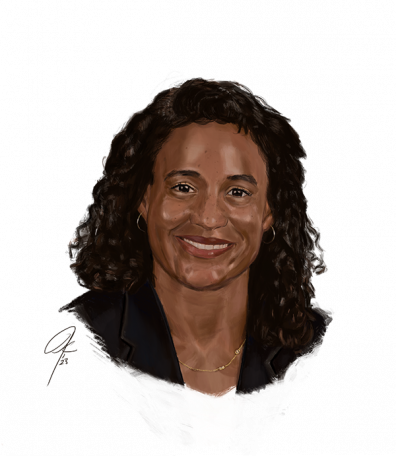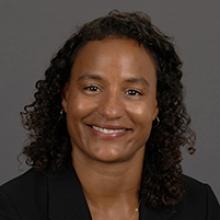Meet the Expert: Candace Hester

Candace Hester’s work addresses systemic social inequities at the intersection of the justice and education systems. She leads rigorous evaluations for programs designed to empower communities and reimagine opportunities for justice-involved youth. She is also a member of the teaching faculty at the University of California, Berkeley’s Goldman School for Public Policy.
POSITION: Principal Researcher
AREAS OF EXPERTISE: Education, juvenile justice, and criminal justice
YEARS OF EXPERIENCE: 10
Q: What piqued your interest in a career in juvenile justice?
Candace: Like so many people at AIR, I started my career in education. As a teacher, I was able to directly observe the chronic, systemic challenges that continue to undermine certain populations, even after decades of intervention. These structural challenges, including mass incarceration, are often rooted in community disinvestment. Seeing how systems like education intersected with justice and health, I started to feel dissatisfied with focusing on just one lane of solutions to those challenges. I’m still highly committed to education, of course, and I’m very inspired by visionary, high-quality educators in this country and around the world. But a solution that only addresses education can’t single-handedly ameliorate the legacy of systemic disadvantage that certain populations face.
Q: What does the word “justice” mean to you?
The way that our justice system operates today is not always about justice, as defined in the dictionary; it’s about punishment. And that’s often not the appropriate response, especially when we’re considering the futures of young people.
Candace: The way that our justice system operates today is not always about justice, as defined in the dictionary; it’s about punishment. And that’s often not the appropriate response, especially when we’re considering the futures of young people—trying to understand and address their needs.
At AIR, we’re thinking about advancing justice—the ideal of it, not our current, real-world justice system in the U.S. To be clear, there are many good people in the justice system, who work very hard to appropriately respond and support young people. At the same time, I know that the mechanisms of justice in this country have created a dynamic where we disproportionately police and criminalize Black and Brown communities; we wrap them up in a system of surveillance that creates enormous ongoing challenges for them. As a society, we need to recognize that and recalibrate the way we police and incarcerate. Then, we need to leverage resources toward community-based solutions.
Q: Your work is intersectional, spanning both the education and justice systems. How do you bridge the gaps between the two?
Candace: Usually, people understand intuitively how these systems are linked. For example, many schools already work closely with community-based organizations and other city or county agencies to support and uphold young people. For example, one of my first projects in the justice space was supporting the city of San Francisco’s Department of Children, Youth, and their Families. In partnership with this coordinating agency, we engaged the justice system, schools, and community-based organizations to consider the broadest structures possible to make San Francisco a great place to grow up. Fast forward five years and I’m fortunate to be working simultaneously in Oakland on the Neighborhood Opportunity and Accountability Board evaluation, where the police and juvenile probation department are actively considering ways that they can partner with community-based programs and even circumvent the justice system where possible.
There’s a common misconception that police and justice want to always be involved in every situation, but that’s not true. They don’t usually want to be the only support system available, especially when there's a wide array of needs that may not align with their strengths. People who work in education, justice, community, out-of-school time programs, and youth development are all enthusiastic about the possibility of expanding community-based supports and creating greater access to them.
Q: How did the Neighborhood Opportunity and Accountability Board (NOAB) project come about?
Candace: When I first heard David Muhammad, executive director of the National Institute for Criminal Justice Reform (the organization which co-developed and continues to implement NOAB) speak, he described how our justice system bakes in bias, by implementing certain surveillance strategies of young people regardless of their specific needs and challenges. For example, sometimes people are incarcerated because they’re violent; other times, they’re incarcerated because they’re homeless. And in both cases, our traditional justice system responses frequently fail to provide the full set of supports that can address the root causes of the challenges people face.
I was immediately sold on NOAB’s premise, which requires embracing the whole person, including misbehavior, but also an individual’s needs and their trauma. The goal is to find a holistic solution that serves both the individual and their community and hopefully breaks an ongoing cycle of justice system involvement.
You can’t just design a system like this and hope for the best. David and I knew it required evaluation, to garner continuous improvement feedback, from both external evaluators and the community. Together, with tremendous thought leaders within and beyond AIR, we dreamed up this evaluation project, which created opportunities for young people to participate in their own outcomes and for the community to weigh in. For now, the program is active in Oakland, California, and Richmond, California, though I wouldn’t be surprised if it takes off in other cities soon.
Q: What is the greatest technical challenge to evaluating juvenile justice programs?
Candace: The main goal of most social science evaluations is to determine whether an intervention is improving individual or collective well-being. Making that determination requires the researcher to identify a counterfactual comparison group—that is, similar set of individuals or communities who have not received the intervention or a similar intervention. The most common and convincing strategy for identifying such a comparison is using a randomized controlled trial. However, there are not many situations in which incarceration or community services are going to be randomly assigned. Nor are there many research conditions that allow us to deeply understand the many ways that incarceration—or community support, for that matter—affect individuals and their communities.
Q: What policy changes could potentially improve racial justice equity?
Candace: As a society, we have created the conditions for major structural inequities, which undermine the capacity for entire populations to thrive. If we took accountability for that, we could then invest in making changes; we could create opportunities to reverse those inequities.
There are great examples of programming where dollars that traditionally went to probation are instead reinvested to create opportunities for young people in and out of school to address their unique needs and interests, as well as any unaddressed trauma. These programs provide exciting ways for young people to engage and celebrate community. Unfortunately, they are also mostly under-developed and disconnected from the sets of supports that are available in higher resourced communities.
Q: Where can we find you on a typical Saturday?
Candace: My nine-year-old son plays a lot of soccer and baseball, and I feel like I spend most of my non-working hours at his games.
Q: What book would you suggest everyone read?
Candace: From the War on Poverty to the War on Crime: The Making of Mass Incarceration in America, by Elizabeth Hinton. She describes in great detail how we have constructed mass incarceration through local and federal policy which disproportionately surveil and criminalize Black and Brown communities. We’ve created a situation in which we are chronically, systemically incarcerating people and then describe it as a kind of cultural problem. For me, this book has been career-changing. As far as I’m concerned, it’s required reading.
